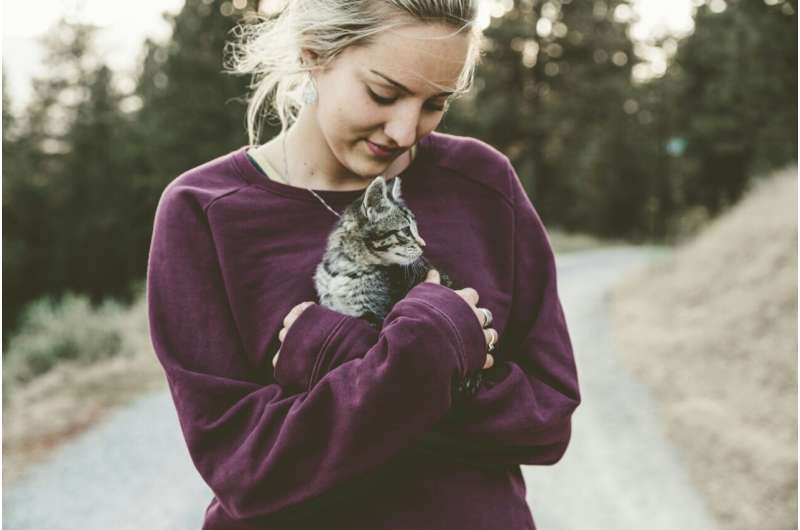This article has been reviewed according to Science X's editorial process and policies. Editors have highlighted the following attributes while ensuring the content's credibility:
fact-checked
trusted source
written by researcher(s)
proofread
Why cats meow at humans more than each other

This is a story that goes back thousands of years.
Originally, cats were solitary creatures. This means they preferred to live and hunt alone, rather than in groups. Most of their social behavior was restricted to mother–kitten interactions. Outside of this relationship, cats rarely meow at each other.
However, as cats began to live alongside humans, these vocalizations took on new meanings. In many ways, when a cat meows at us, it's as if they see us as their caregivers, much like their feline mothers.
Cats probably first encountered humans roughly 10,000 years ago, when people began establishing permanent settlements. These settlements attracted rodents, which in turn drew cats looking for prey. The less fearful and more adaptable cats thrived, benefiting from a consistent food supply. Over time, these cats developed closer bonds with humans.
Unlike dogs, which were bred by humans for specific traits, cats essentially domesticated themselves. Those that could tolerate and communicate with humans had a survival advantage, leading to a population well-suited to living alongside people.
To understand this process, we can look at Russian farmed fox experiments. Beginning in the 1950s, Soviet scientist Dmitry Belyaev and his team selectively bred silver foxes, mating those that were less fearful and aggressive toward humans.
Over generations, these foxes became more docile and friendly, developing physical traits similar to domesticated dogs, such as floppy ears and curly tails. Their vocalizations changed too, shifting from aggressive "coughs" and "snorts" to more friendly "cackles" and "pants," reminiscent of human laughter.
These experiments demonstrated that selective breeding for tameness could lead to a range of behavioral and physical changes in animals, achieving in a few decades what would usually take thousands of years. Though less obvious than the differences between dogs and the ancestral wolf, cats have also changed since their days as African wildcats. They now have smaller brains and more varied coat colors, traits common among many domestic species.
Cats' vocal adaptations
Like the silver foxes, cats have adapted their vocalizations, albeit over a much longer period of time. Human babies are altrical at birth, meaning they are entirely dependent on their parents. This dependency has made us particularly attuned to distress calls—ignoring them would be costly for human survival.
Cats have altered their vocalizations to tap into this sensitivity. A 2009 study by animal behavior researcher Karen McComb and her team gives evidence of this adaptation. Participants in the study listened to two types of purrs. One type was recorded when cats were seeking food (solicitation purr) and another recorded when they were not (non-solicitation purr). Both cat owners and non-cat owners rated the solicitation purrs as more urgent and less pleasant.
An acoustic analysis revealed a high-pitch component in these solicitation purrs, resembling a cry. This hidden cry taps into our innate sensitivity to distress sounds, making it nearly impossible for us to ignore.
But it's not just cats that have adapted their vocalizations: we have too. When we talk to babies, we use "motherese", more commonly known as "baby talk," characterized by a higher pitch, exaggerated tones and simplified language. This form of speech helps engage infants, playing a role in their language development.
We've extended this style of communication to our interactions with pets, known as pet-directed speech. Recent research suggests that cats respond to this form of communication. A 2022 study by animal behavior researcher Charlotte de Mouzon and colleagues found that cats could distinguish between speech addressed to them and speech addressed to adult humans. This pattern of discrimination was particularly strong when the speech came from the cats' owners.
Our adoption of pet-directed speech reinforces a bond that mirrors mother-kitten interactions.
Changes in vocalizations are not only seen in cat-human relationships. Compared to the ancestral wolf, dogs have expanded their barking behavior to communicate more effectively with humans and, just as with cats, we use pet-directed speech when interacting with dogs.
Over time, cats have evolved to use vocal signals that resonate with our nurturing instincts. Paired with our use of pet-directed speech, this two-way communication highlights the unique relationship we've developed with our feline friends. It seems cats might be the winners in this relationship, adapting to solicit care and attention from us. Still, a lot of cat owners wouldn't have it any other way.
Provided by The Conversation
This article is republished from The Conversation under a Creative Commons license. Read the original article.![]()



















